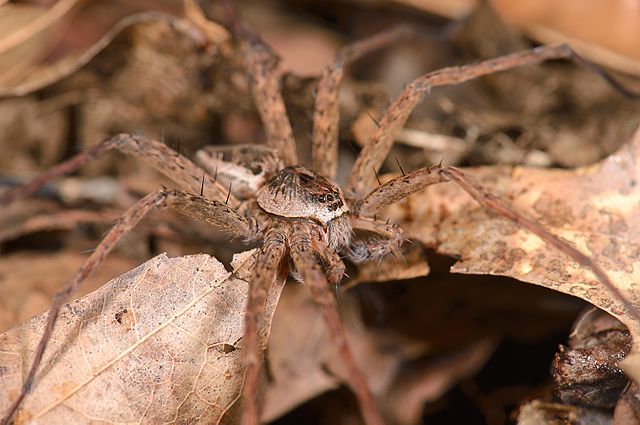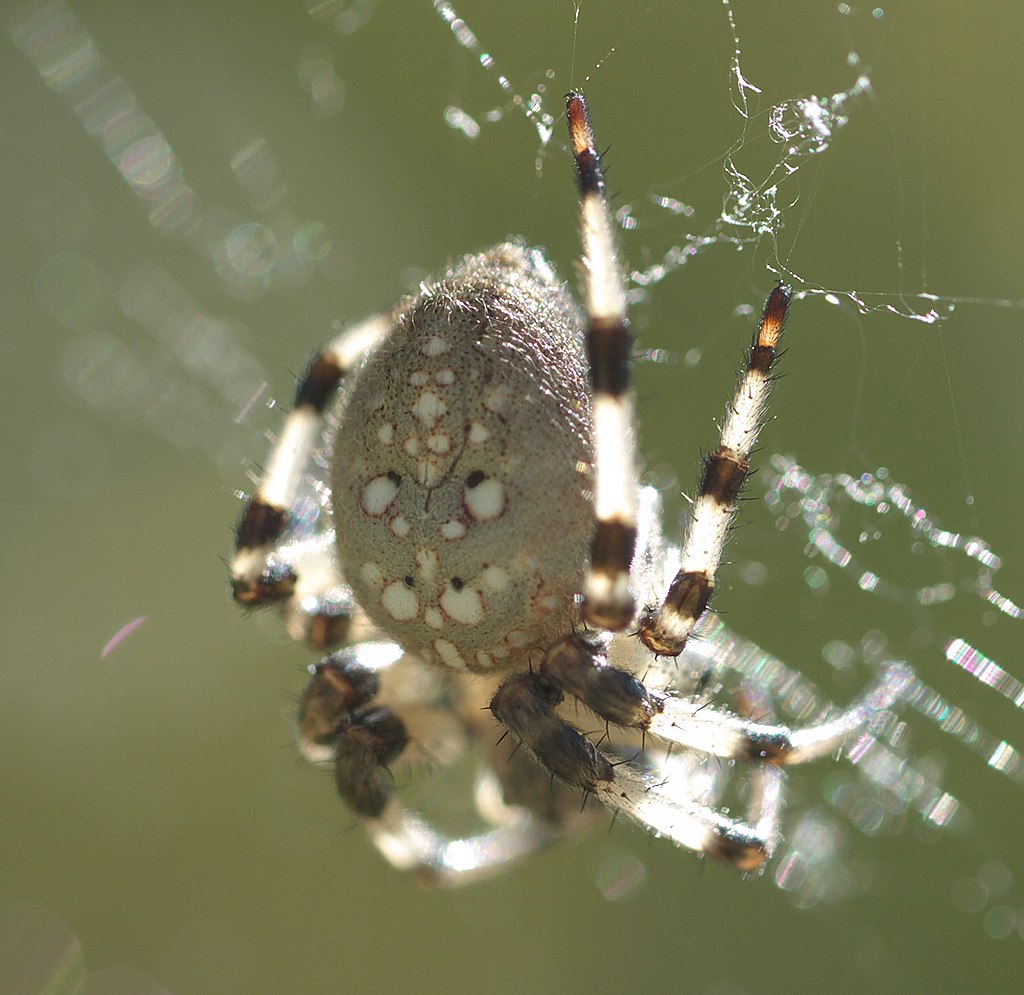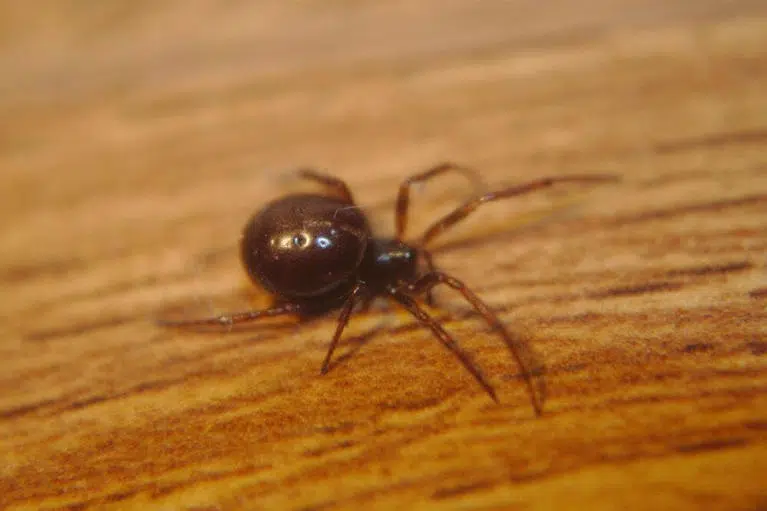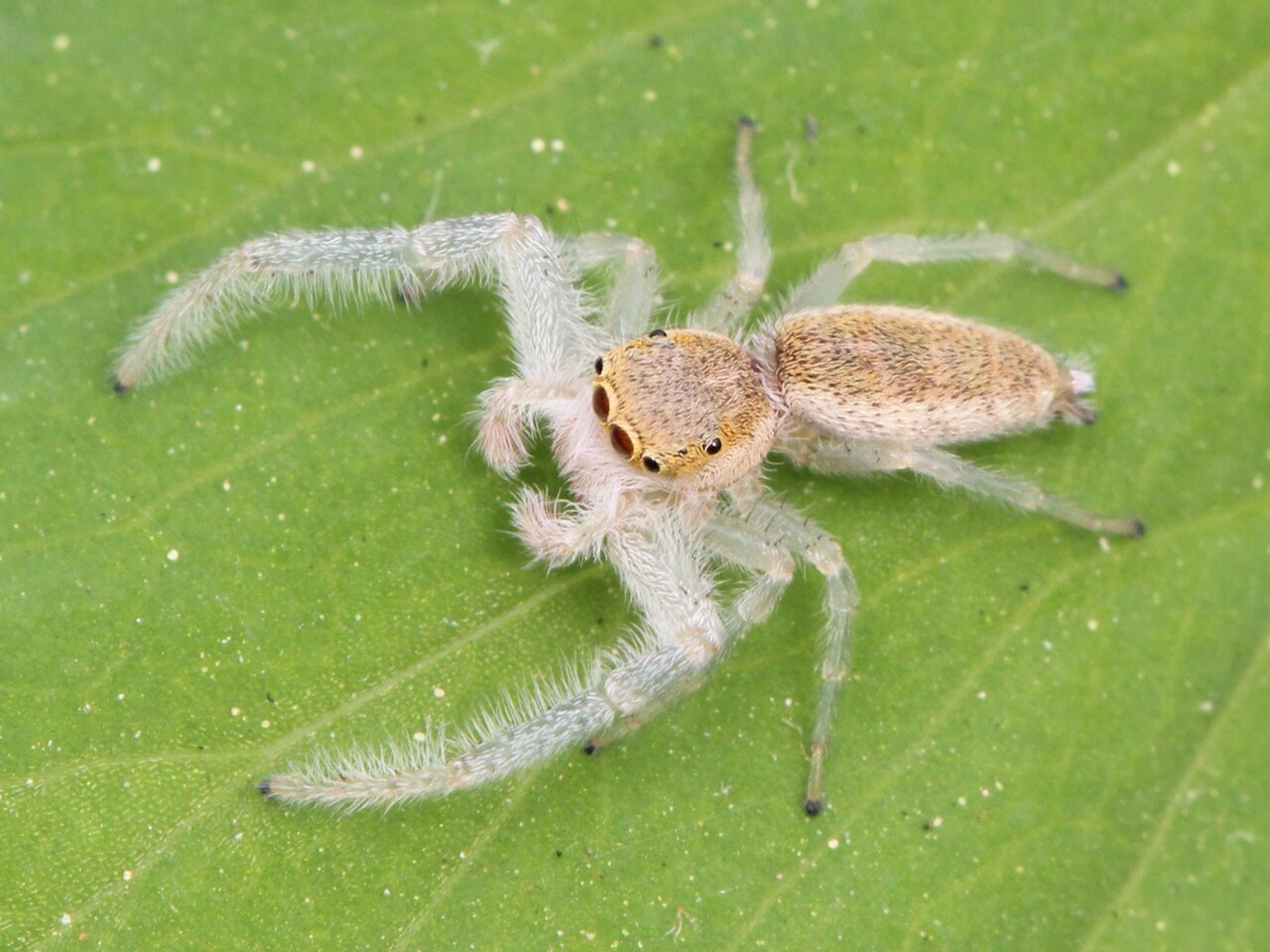Common spiders in Minnesota include jumping spiders and fishing spiders. Most spiders in the state aren’t dangerous to humans.
Hundreds of spider species are seen in Minnesota but the following types are the most common.
Table of Contents
1. Yellow Garden Spider
Scientific name: Argiope aurantia.
Common name: yellow garden spider, black and yellow garden spider, golden garden spider, writing spider, zigzag spider, zipper spider, black and yellow argiope, corn spider, Steeler spider, McKinley spider.
Yellow Garden Spiders are common in Minnesota. Also referred to as black and yellow spiders, the species is identified by its yellow and black body and legs’ colors. It is part of the Argiope species, which represents a large spider.

Male Yellow Garden Spiders reach a length of up to 9mm while females reach a length of up to 28mm.
The spider’s venom isn’t dangerous to humans as it’s often compared to a bee’s sting. However, it is believed this venom could have a therapeutic effect for its polyamine toxins content.
2. Zebra Jumping Spider

Scientific name: Salticus scenicus.
Common name: zebra jumping spider.
The Zebra Jumping Spider looks similar to the Yellow Garden Spider. However, it features white and black stripes which make it easier to distinguish. The Zebra Jumping Spider is also smaller. Males reach a maximum length of 6mm while females reach a maximum length of 9mm.
The spider is a good hunter. With good vision, it often looks for larger prey. The spider is looking for moths and even mosquitoes 2-3 times its size.
The spider might be known for jumping for its prey but it’s also good at dancing. Make Zebra Jumping Spiders dance before female spiders before the mating ritual as a means of making a good impression.
3. Bold Jumping Spider

Scientific name: Phidippus audax.
Common name: daring jumping spider, bold jumping spider.
The small Bold Jumping Spider is also sometimes referred to as the Daring Jumping Spider. Part of the Salticidae family, it’s a small spider that rarely reaches a length of 10mm. However, it is easy to recognize as it has the same black and red colors as the famous Black Widow.
The Bold Jumping Spider prefers to hunt for its prey out in the open territory. Its stereoscopic vision allows it to be one of the true hunters of the Salticidae family.
It’s also a friendly spider about humans as few bites have been reported. It’s assumed human bites of the Bold Jumping Spider aren’t followed by extreme reactions but rather by mild reactions such as itchy skin in the area of the bite.
4. Dark Fishing Spider

Scientific name: Dolomedes tenebrosus.
Common name: dark fishing spider.
The large Dark Fishing Spider is an agile hunter. It can often be seen on the surface of the water where it hunts its prey actively. It’s looking for insects that live near water sources. The spider also looks for small species of fish.
You can recognize the Dark Fishing Spider by its dark brown color and its hairy body and legs. The legs of the spider are long. The female’s legs can even reach lengths of up to 90mm.
While the spider is known to live around water sources it’s believed to be as passionate about solely hunting around and on the water as other fishing spiders. As a result, it can also be found a few miles away from water sources, especially in woodlands.
5. Goldenrod Crab Spider

Scientific name: Misumena vatia.
Common name: goldenrod crab spider, flower (crab) spider.
This spider is known for its crab-like aesthetics and behavior. The yellow spider is known for walking sideways similar to crabs. It generally lives on flowers where it looks for insects and where it is also hunted by large insects.
This spider also has a distinct capability of changing colors depending on its environment. It sometimes changes its color to pale white, particularly when hunting. But the spider is generally seen in its vivid yellow color.
Mating processes for these spiders are complex. Female spiders are completely stationary while male Goldenrod Crab Spiders can travel long distances to find a suitable mating partner.
6. Banded Garden Spider

Scientific name: Argiope trifasciata.
Common name: banded garden spider, banded orb weaving spider.
This spider species lives at ground level. It prefers to create perfectionist concentric weaves where it waits for its prey. Insects are among their favorite prey. The spider is typically found in the middle of the web where it can standstill for hours.
The looks of this spider are also distinct. It can be characterized as a bright color spider with lines and markings on its back. However, while it is a bright spider it is also a small spider. The Banded Garden Spider reaches a maximum size between 5 and 9mm in adulthood.
7. American Nursery Web Spider

Scientific name: Pisaurina mira.
Common name: American nursery web spiders.
The American Nursery Web Spider is mostly seen in areas close to woods. It prefers to hunt in the zones between woodlands and fields.
This spider is part of the Pisauridae family. It’s known for its brown color which makes it stand out when seen on tall grass as it prefers to hunt on ground level.
This spider is also famous for its fatal mating behavior. The male ties the legs of the female in spider silk to avoid being eaten alive just before the mating process. However, this doesn’t stop the male American Nursery Web Spider to have multiple female partners. If it manages to escape cannibalism the male spider will move on to court another female.
8. Asiatic Wall Jumping Spider

Scientific name: Attulus fasciger.
Common name: Asiatic Wall Jumping Spider.
The Asiatic Wall Jumping Spider came to Minnesota from Asia. It has been a spider species that have been introduced to the state by travelers. It has now been reported all across the US, particularly around the Rocky Mountains.
This spider comes from Eastern Asia from countries such as Japan and Korea. It is characterized by a short, round, and flat body. It has a black body color paired with yellow and white hairs that grow on its body and its legs.
9. Marbled Orbweaver

Scientific name: Araneus marmoreus.
Common name: marbled orbweaver, pumpkin spider.
This spider is known for its bulbous shape. Often compared to pumpkins due to this shape, it is a spider of orange-red color with some yellow variations and coloration on the back. The spider is not fast and this means it needs a web to catch insects and bugs.
Marbled Orbweavers can be found in woodlands at the grass level. Here, they start to create complex silk webs. A single line is connected to the spider which has the role of alerting it whenever something gets caught in the web through vibrations.
10. Spotted Orbweaver

Scientific name: Neoscona crucifera.
Common name: Hentz orbweaver, spotted orbweaver, barn spider.
Spotted Orbweavers were first documented in 1839. This spider is a bit more difficult to identify for a beginner. It comes in various orange and brown shades which makes it a bit more difficult to spot. Since it is a nocturnal spider it is even more difficult to see.
However, this spider doesn’t live in remote areas. It is often called the Barn Spider as it prefers to live near homes. It prefers man-made structures where it weaves large webs.
Spotted Orbweavers that don’t live near human-made constructions are mostly found in woodlands. It’s here that the female of the species can venture out for food even during the day.
11. Eastern Parson Spider

Scientific name: Herpyllus ecclesiasticus.
Common name: eastern parson spider.
This unusual spider species gets its name from the ranks of ecclesiology. Its body shape resembles a ruffled tie. Such ties used to be worn by 18th-century clergymen. This is why the spider has been named after the shape of this tie.
However, the spider is not friendly to humans. Eastern Parson Spider bites are rare. But they are painful when they occur.
Most Eastern Parson Spider bites can be avoided by checking clothes after working in the garden or by clearing clothes whenever out on a walk in the woodlands.
12. Bronze Jumping Spider

Scientific name: Eris militaris.
Common name: bronze jumper or bronze lake jumper.
The Bronze Jumping Spider only has brown markings on the abdomen while the body has a black color. This spider is common around Minnesota and the rest of the US. It is easy to find in rural areas or in suburban areas as it prefers a tranquil environment.
The spider is part of the Salticidae family. This is the largest family of spiders. While it lacks medical importance, it’s one of the species with good vision. It’s also believed to be one of the spiders with complex mating rituals.
13. Grey Cross Spider

Scientific name: Larinioides sclopetarius.
Common name: bridge spider, gray cross spider.
The Grey Cross Spider is known for its circular orb webs. These webs are typically found under bridges or other similar man-made structures.
Believed to originate in Europe, the Grey Cross Spider is among the few spiders in the state that isn’t particularly attracted to grass, woodlands, and vegetation. It prefers to live on steel structures.
The spider is also a nocturnal hunter. It is attracted by sources of light during the night. As a result, the best spot to find it is under bridges near artificial light sources.
14. Arabesque Orbweaver

Scientific name: Neoscona arabesca.
Common name: Arabesque Orbweaver.
The Arabesque Orbweaver is a species of spiders without medical importance. It’s believed to be one of the most popular spiders around the world as it has been found on all continents.
This spider prefers to weave weaves and to expect its prey to get caught in it. Female spiders are responsible for the weave even if they can’t be spotted on it during the day.
Female spiders prefer to hide away tucked from possible predators during the day. The female Arabesque Orbweaver is normally found in curved leaves, typically close to a spider web.
15. Flea Jumping Spider

Scientific name: Naphrys pulex.
Common name: Flea Jumping Spider.
The Flea Jumping Spider isn’t tied by man-made borders. While found in Minnesota, it’s also a spider that is common through the US and beyond in Canada.
This spider species is friendly to humans. Recognizable by its hairy body, it’s still an agile hunter.
The Flea Jumping Spider can jump a few times its body length.
The spider is among the spiders that are avid hunters. It takes on prey as large or twice as large its size.
Those planning to raise the Flea Jumping Spider in captivity should ensure they have sufficient food even if they can go for weeks without eating. Flies are the favorite prey of the Flea Jumping Spider.
16. Striped Fishing Spider

Scientific name: Dolomedes scriptus.
Common name: Striped fishing spider.
The Striped Fishing Spider gets its name from the Latin word ‘scriptus’. This spider species looks like it has been written on, as its name suggests.
Female Striped Fishing Spiders are larger than their male counterparts. They can grow up to 6 inches in size.
While larger, this spider species does have plenty of predators. Snakes and wasps are among the top predators actively seeking to hunt the Striped Fishing Spider.
17. Dimorphic Jumping Spider

Scientific name: Maevia inclemens.
Common name: Dimorphic Jumping Spider.
With a rectangular shape, these jumping spiders are one of the multiple Maevia species. As their name suggests, these spiders can jump. They jump long distances given they have strong short back legs.
The Dimorphic spider is also known for having very good vision. This is a must given it often hunts flies from a distance.
18. Shamrock Orbweaver

Scientific name: Araneus trifolium.
Common name: Shamrock orb weaver.
The Shamrock Orbweaver is just one of the spiders also called a Pumpkin Spider. This nickname comes from its rounded shape that resembles a pumpkin. The spider is brown, yellow, or orange with a few white spots.
This beefy spider is also known for making large webs. They can be as large as two feet. But the spider can also be dangerous to humans. While its bite is not severe, it is painful.
19. Triangulate Combfoot

Scientific name: Steatoda triangulosa.
Common name: triangulate cobweb spider, triangulate bud spider.
This home spider is known to live in areas with light sources. It creates a large web either inside or outside of the house around light bulbs which tend to attract insects.
However, it’s not dangerous to humans and it doesn’t require professional extermination to get out of the house.
The spider can be recognized by its long yellow legs and dark brown-red body. It also features distinct bright triangles on its body. It can be found hanging upside down near its web waiting for insects to get trapped in it.
20. Six-spotted Fishing Spider

Scientific name: Dolomedes triton.
Common name: six-spotted fishing spider, dock spider.
The Six-spotted Fishing Spider is a type of Dolemedes that lives both on water and near water. It’s an agile hunter using both good vision and tactile tactics to hunt insects near water sources. This spider can also attack small fish up to a few times its size.
It uses venom to immobilize all of its prey. However, the spider is also prey in its turn. Its hunters are mostly birds and bats. However, large fish can also eat the Six-spotter Fishing spider even if it typically stays at water surface level.
21. Brilliant Jumping Spider

Scientific name: Phidippus clarus.
Common name: Brilliant Jumping Spider.
The Brilliant Jumping Spider lives on grass, plants, and flowers. It hangs upside-down waiting for its prey. Its attacks are quick and typically successful.
The spider might be small (up to 5mm males) but it’s still agile. It carries out multiple attacks during the day given the occasion.
These spiders are also very picky when it comes to mating. Females always go for the largest Brilliant Jumping Spider. Male spiders also tend to choose the largest Brilliant Jumping Spider females. They do this because large females can lay extra dozen eggs.
22. Boreal Combfoot

Scientific name: Steatoda borealis.
Common name: Boreal combfoot.
The Boreal Combfoot spider is mostly found in Northern states such as Minnesota. This spider can be identified by a ‘T’ shaped mark on its lower abdomen. This mark is of white or yellow color as opposed to its dark-colored body.
Part of the Theridiidae family. These spiders are known for spinning sticky silk instead. It catches prey easily as opposed to the wooly sill.
23. Six-spotted Orbweaver

Scientific name: Araniella displicata.
Common name: Six-spotted orb weaver.
The Six-spotted Orbweaver is a spider species found on flowers and plants. It lives in areas where flies and bees are attracted to flower nectar as these are the best locations with real chances of catching its favorite prey.
The spider features bright yellow abdomen coloration which is believed to be influenced by the colored flowers it lives on. But the spider also has either three or four spots on its back. Most of the times it has been spotted has been on sunflower.
24. Cat-faced Orbweaver

Scientific name: Araneus gemmoides.
Common name: Cat-faced spider, jewel spider.
The Cat-faced Orbweave lives both in areas with humans and in depopulated areas. It creates a web near light sources when around the house.
However, the spider might be difficult to identify since it tends to change colors. It has been shown the Cat-Faced Orbweaver changes color from light to dark as summer ends and as winter approaches.
The spider has distinct mating rituals, just as most other spiders. However, the female of the species is known to die right after the eggs are laid. Spiderlings are cannibalistic eating each other, especially through the winter.
25. White-jawed Jumping Spider

Scientific name: Hentzia mitrata.
Common name: white-jawed jumping spider.
This almost invisible spider is often called the Crown Spider. It features contrasting coloration on its head and back. The other areas of the body are largely transparent, making it hard to spot in some locations.
The spider is an avid hunter, just as most other jumping spiders. However, it can move its head to follow prey. At the same time, it’s believed it moves its eyes to follow its prey as well.
Mating characteristics include a resemblance of young males to adult females. This is believed to be a defensive technique that protects young White-jawed Jumping spiders from possible attacks from other adult male spiders of the species, mostly for the attention of females.
26. Filmy Dome Spider

Scientific name: Neriene radiata.
Common name: filmy dome spider.
The distinct dome-shaped web of this spider is what inspired its name. The spider creates large dome-like webs and it waits for its prey in its vicinity. The spider is typically two-toned, typically black and white.
The male of the species is smaller than the female. But both the male and the female are nocturnal. This means they only come out at night preferring to hide away from potential predators during the day.
27. Common White-cheeked Jumping Spider

Scientific name: Pelegrina proterva.
Common name: common white-cheeked jumping spider.
This jumping spider resembles some species of frogs. It’s rather small as the male measures up to 6 mm and the female measures up to 9mm. However, it’s a species of spider that comes with distinct white stripes that run along its abdomen so identification is not difficult.
Like most jumping spiders its body is adapted for jumping as far as possible. This is why this spider has short legs.
28. Tan Jumping Spider

Scientific name: Platycryptus undatus.
Common name: tan jumping spider.
The Tan Jumping Spider has a thin body that looks compressed. This is an adaptation that allows it to crawl in areas that are too difficult to reach for other spiders such as under tree barks.
The Tan Jumping Spider is also dark in color that makes it difficult to spot when sitting on tree bark.
The spider prefers to actively hunt its prey rather than creating a web. It’s also a courageous spider as it has been reported it doesn’t back down when it sees humans. However, its bite isn’t dangerous to humans.
29. Barn Funnel Weaver

Scientific name: Tegenaria domestica.
Common name: barn funnel weaver (in North America), domestic house spider (in Europe).
The Barn Funnel Weaver was believed to be related to the Giant House Spider. However, it’s a distinct species that likes living in human-populated areas. It features yellow, brown, or orange coloration.
Males and females can be distinguished by size. But the male Barn Funnel Weaver is larger than the female as it has longer legs.
The spider is also known for its effective funnel-like web.
30. Long-bodied Cellar Spider

Scientific name: Pholcus phalangioides.
Common name: daddy long-legs spider, long-bodied cellar spider, skull spider.
The Long-bodies Cellar Spider is also known as daddy-long-legs. This efficient spider was believed to be dangerous to humans but it cannot bite sufficiently to penetrate the skin.
This spider species is often found in damp cool places such as basements. But it can also be found out in nature on ground level around rocks and trees.
This spider species is dangerous to other spiders, however. It has been known to kill different types of venomous spiders. It’s a type of spider that creates a web to catch insects and flies but it also gets off the web to actively hunt other insects and other spiders.
Some medical importance has also been tied to this species. It’s believed its venom is high in an anti-microbial agent called P. phalangioides.